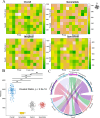Distinct strategies of soil bacterial generalists and specialists in temperate deciduous broad-leaved forests
- PMID: 40736419
- PMCID: PMC12366338
- DOI: 10.1128/aem.00992-25
Distinct strategies of soil bacterial generalists and specialists in temperate deciduous broad-leaved forests
Abstract
Based on global biotic homogenization, habitat generalists and specialists play an important role in maintaining the stability of ecosystems. However, limited information is available about the assembly processes and co-occurrence patterns of soil bacterial habitat specialists and generalists in forest ecosystems, particularly their response mechanisms to environmental factors. In this study, high-throughput sequencing technology was used to investigate the role of the ecological assemblage processes of soil bacterial habitat specialists and generalists and their role in maintaining the stability of the symbiotic network in temperate deciduous broad-leaved forests (China). The results showed that compared with specialists, the diversity of bacterial habitat generalists was lower, but their distribution ranges and environmental niche breadth were wider. Results from the null and neutral models indicate that, compared to deterministic processes, the community assembly of habitat generalists and specialists is more strongly influenced by stochastic processes, with generalists exhibiting a higher degree of stochasticity than specialists. Network analysis results showed that habitat specialists played a greater role in maintaining the stability of the bacterial co-occurrence network than the generalists. In addition, bacterial habitat specialists were more likely to be affected by light and spatial feature vectors than generalists. These findings provide a novel perspective for understanding the assembly processes and diversity maintenance mechanisms of the forest soil bacterial community.
Importance: Limited information is available about bacterial specialists and generalists in forests. Generalists were more affected by stochastic processes than specialists. Specialists played a more important role in network stability than generalists. Light and spatial vectors had stronger effects on specialists than generalists.
Keywords: co-occurrence network; community assembly process; habitat generalists; habitat specialists; niche breadth; soil bacteria.
Conflict of interest statement
The authors declare no conflict of interest.
Figures






Similar articles
-
Soil microorganism distributions depend on habitat partitioning of topography in a temperate mountain forest.Microbiol Spectr. 2025 Jul;13(7):e0205624. doi: 10.1128/spectrum.02056-24. Epub 2025 May 28. Microbiol Spectr. 2025. PMID: 40434074 Free PMC article.
-
Contrasting the Relative Importance of Microbial Generalists and Specialists in Maintaining Assembly Processes and Community Stability.Environ Microbiol. 2025 Aug;27(8):e70167. doi: 10.1111/1462-2920.70167. Environ Microbiol. 2025. PMID: 40782060
-
Biodiversity Patterns and Community Construction in Subtropical Forests Driven by Species Phylogenetic Environments.Plants (Basel). 2025 Aug 2;14(15):2397. doi: 10.3390/plants14152397. Plants (Basel). 2025. PMID: 40805746 Free PMC article.
-
Home treatment for mental health problems: a systematic review.Health Technol Assess. 2001;5(15):1-139. doi: 10.3310/hta5150. Health Technol Assess. 2001. PMID: 11532236
-
A rapid and systematic review of the clinical effectiveness and cost-effectiveness of paclitaxel, docetaxel, gemcitabine and vinorelbine in non-small-cell lung cancer.Health Technol Assess. 2001;5(32):1-195. doi: 10.3310/hta5320. Health Technol Assess. 2001. PMID: 12065068
References
-
- Chen YJ, Leung PM, Wood JL, Bay SK, Hugenholtz P, Kessler AJ, Shelley G, Waite DW, Franks AE, Cook PLM, Greening C. 2021. Metabolic flexibility allows bacterial habitat generalists to become dominant in a frequently disturbed ecosystem. ISME J 15:2986–3004. doi: 10.1038/s41396-021-00988-w - DOI - PMC - PubMed
-
- Clavel J, Julliard R, Devictor V. 2011. Worldwide decline of specialist species: toward a global functional homogenization? Frontiers in Ecol & Environ 9:222–228. doi: 10.1890/080216 - DOI
MeSH terms
Grants and funding
LinkOut - more resources
Full Text Sources

